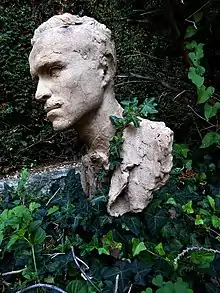Emil Beurmann
Life
Beurmann was born and grew up in Basel. From an early age he was writing (both prose and poetry) and painting.
He undertook an apprenticeship as a decorative painter, also taking lessons with Hans Sandreuter. An early influence at this stage was his fellow student Lisa Ruutz, later known as the poet Lisa Wenger.
In 1881 he travelled to Paris, at that time an "artists' mecca".[3][4] He found himself a cheap room in the Latin Quarter and quickly made contact with high-profile artists including Albert Anker, Lovis Corinth, Cuno Amiet und Giovanni Giacometti. There followed a period combining study with travel that took in Germany, Italy, France, Turkey, Spain and Egypt where he lived for a year or so in Cairo, living with his two models Nebiha and Chadiga. After this he settled back home in Basel where he was able to make a living producing portraits, although he came to dislike this work. He then successfully identified a new source of income: drawing inspiration from his travels, he produced a series of humorous travel books, also contributing articles and features on fellow artists to the National Zeitung (as the newspaper was known at that time). He owes his reputation as the "city poet" to a series of amusing newspaper columns he contributed under the pseudonym "Beuz".[2]
In 1892, Beurmann painted Basler Gedenkfeier, a work in the style of Art Nouveau, that became the poster for the 500-year jubilee celebrating the union of Grossbasel and Kleinbasel in 1392.[5][6][7] He became a member of the Basel city Theatre Commission in 1900,[8][9] and was entrusted with looking after the theatre's costume collection. In his later years he lived with his wife Mariely (who was 25 years younger than he) at a city centre address near the river, along the prestigious "Wettsteinallee".[10] Their home became a focus for the cultural elite of the day, with visitors such as Richard Strauss, Max Reinhardt and the Viennese writer, Arthur Schnitzler.[10] At the age of 75, Emil Beurmann wrote, based on Johann Nestroy's posse Der böse Geist Lumpacivagabundus, the Baslerdüütsch libretto for Hans Haug's operetta E liederlig Kleeblatt (lit. 'A lascivious trio'). The operetta premiered at the Basler Stadttheater on 3 September 1938, and was a public success.[11]
Selected bibliography
- Emil Beurmann (1930). Emanuel meint ...: Gedichte u. Geschichten (in German). Buchdruckerei zum Hirzen.
- Emil Beurmann (1935). Gix und Gax (in German). Hirzen-Verlag, Buchdr. zum Hirzen A.-G.
- Emil Beurmann (1941). So sah es Beuz: Gedichte (in German). Hirzen-Verlag.
References
- Matthias Buschle; Daniel Hagmann (6 October 2008). Gräber und Geschichten: Basel und seine Toten (in German). Christoph Merian. pp. 26–. ISBN 9783856163785.
- "Beurmann, Emil Angaben zur Person". Basler Literarisches Archiv- Basler [Autorinnen und Autoren] A-Z. Susanne Gubser, lic.phil. i.A. Universitätsbibliothek, Basel. Retrieved 7 May 2016.
- Dorothea Christ; Kunsthalle Basel (1980). Maler und Bildhauer der Basler Künstler Gesellschaft, 1850–1950: Kunsthalle Basel, 13. Juli bis 14. September 1980 (in German). Schwabe. pp. 32–. ISBN 9783796507670.
Emil Beurmann 1862–1951 Emil Beurmann zählt zu den vielseitigsten, spritzigsten Künstlern Basels —dies nicht so sehr seiner malerischen Tätigkeit wegen, sondern weil er als Schriftsteller, Kritiker und Karikaturist lebendig und oft auch ... 1881/82 war Beurmann an der Ecole des Arts decoratifs in Paris, anschliessend an der Akademie in Karlsruhe.
- Emil Beurmann (1941). So sah es Beuz: Gedichte (in German). Hirzen-Verlag. pp. 130–.
Als ich im Herbst 1881 zum ersten Mal in Paris war und wochenlang, eine Mappe voll Studien unter dem Arm, als Dekorationsmaler vergeblich in allen Geschäften nach Arbeit umschaute und mir die Beine ablief, ...
- Jean-Charles Giroud (2006). Art Nouveau and the Swiss Poster. P. Cramer. pp. 34–.
... yet a number of Swiss pioneers emerged. In Basle the painter Emil Beurmann produced a number of posters that were permeated by the principles of Art Nouveau. His early works, such as Basler Gedenkfeier 1392-1892 (1892), relied on ...
- Christoph-Merian-Stiftung (Basel) (1997). Basler Stadtbuch (in German). Vol. 117. Merian-Verl. pp. 135–.
Ein optisches Gedächtnis der Schweiz Hundert Jahre Basler Plakatsammlung Plakat zur <Basler Gedenkfeier 1892> von Emil ... Emil Beurmann, der 1892 ein Plakat zur 500- Jahr- Feier der Vereinigung von Gross- und Kleinbasel geschaffen ...
- Monika Schib Stirnimann (2001). Weltformat: Basler Zeitgeschichte Im Plakat (in German). Christoph-Merian-Verlag. pp. 64–. ISBN 978-3-85616-141-5.
Rolf Thalmann Basel als Plakatstadt Basler Gedenkfeier 1892 zur Erinnerung an die Vereinigung von Gross- und Kleinbasel im Jahre 1392. (Entwurf Emil Beurmann) In den achtziger und neunziger Jahren haben findige Köpfe immer wieder ...
- Thomas Blubacher (2011). Oskar Wälterlin und sein Theater der Menschlichkeit (in German). Henschel. pp. 232–. ISBN 978-3-89487-662-3.
Der Kunstmaler und Schriftsteller Emil Beurmann (1862-1951) war seit 1900 Mitglied der Theaterkommission. ...
- UB Basel. "Basler Literarisches Archiv: Autoren: Beurmann, Emil". Retrieved 12 May 2016.
- Corina Lanfranchi (2003). Literaturführer Basel: Personen und Schauplätze (in German). Merian. pp. 20–. ISBN 978-3-85616-201-6.
An der Wettsteinallee, wo er mit seiner fünfundzwanzig Jahre jüngeren Gattin lebt, empfängt er Richard Strauss, Max ... Literatur: Steuri, Eduard: Emil Beurmann, der Dichtermaler, in: Basler Jahrbuch 1952, Basel 1953; Leuzinger, Fridolin ...
- Basler Jahrbuch (in German). Verlag von Helbing & Lichtenhahn. 1940. pp. 175–.
... laufenden «Schlagern» der Saison, Heyne-Hausmanns «Herzlich willkommen» und Haug-Beurmanns «E Liederlig Kleeblatt» (eine Dialekt-Parodie von Nestroy), absieht, zwei Uraufführungen, die sensationell aufgemacht worden waren.
